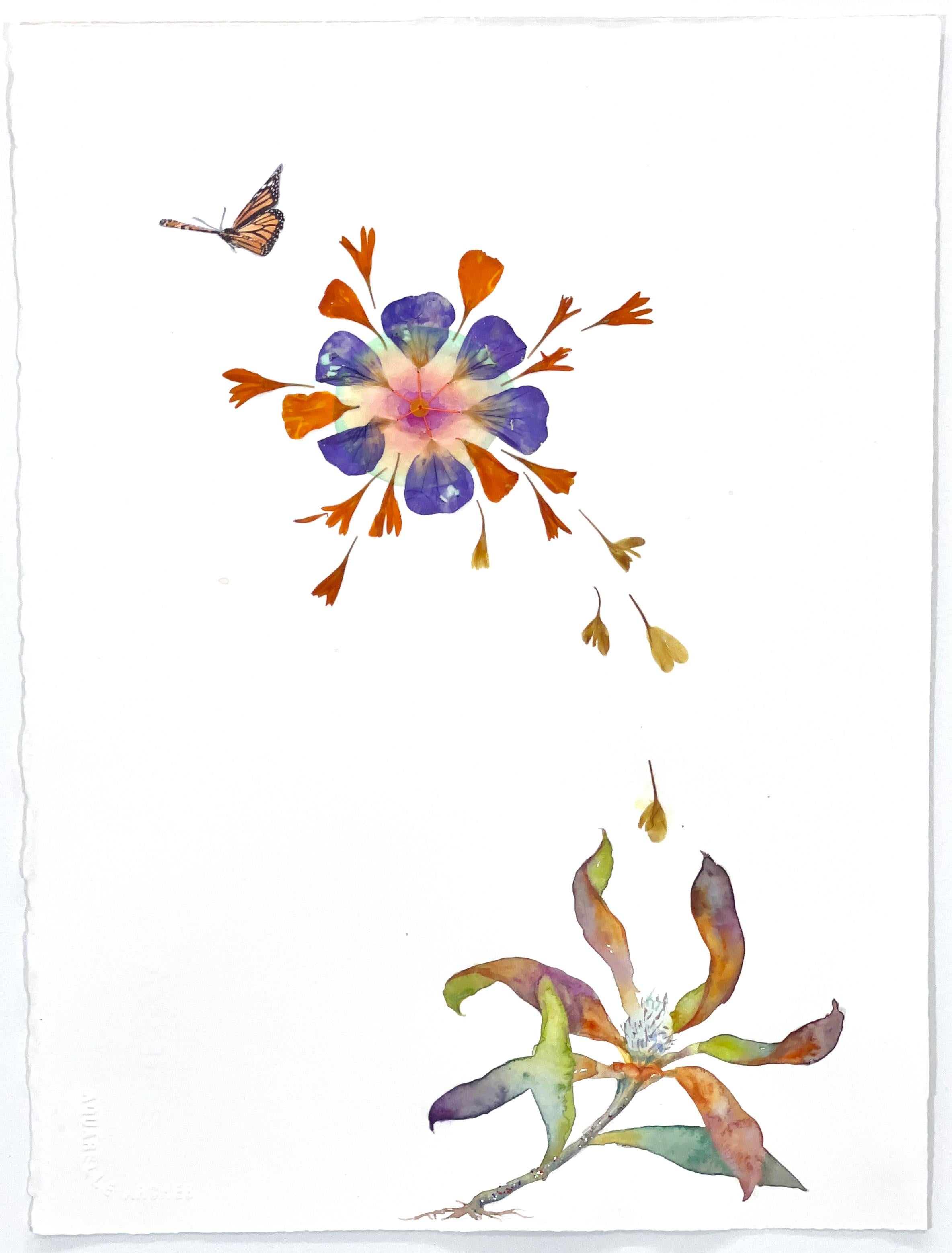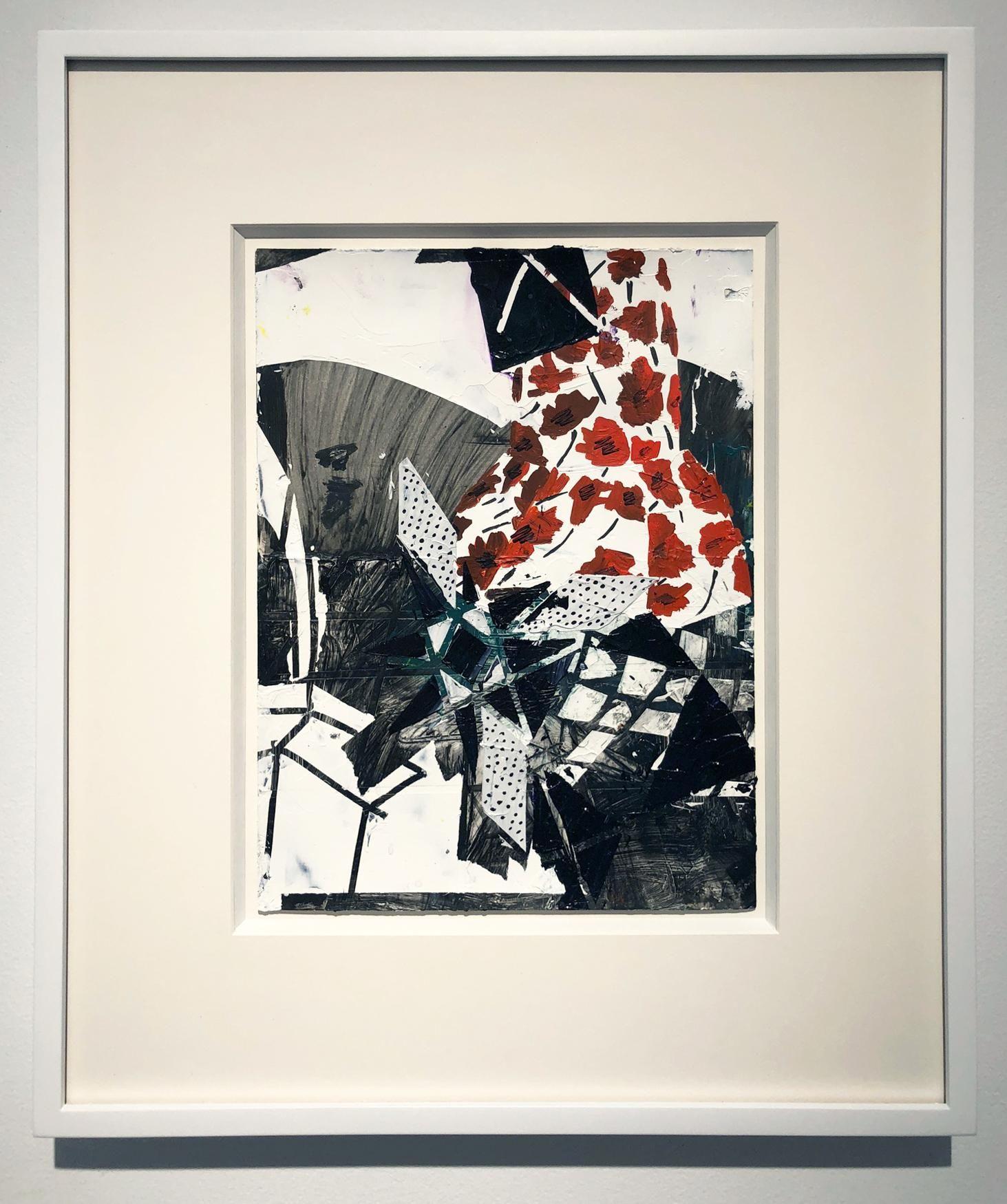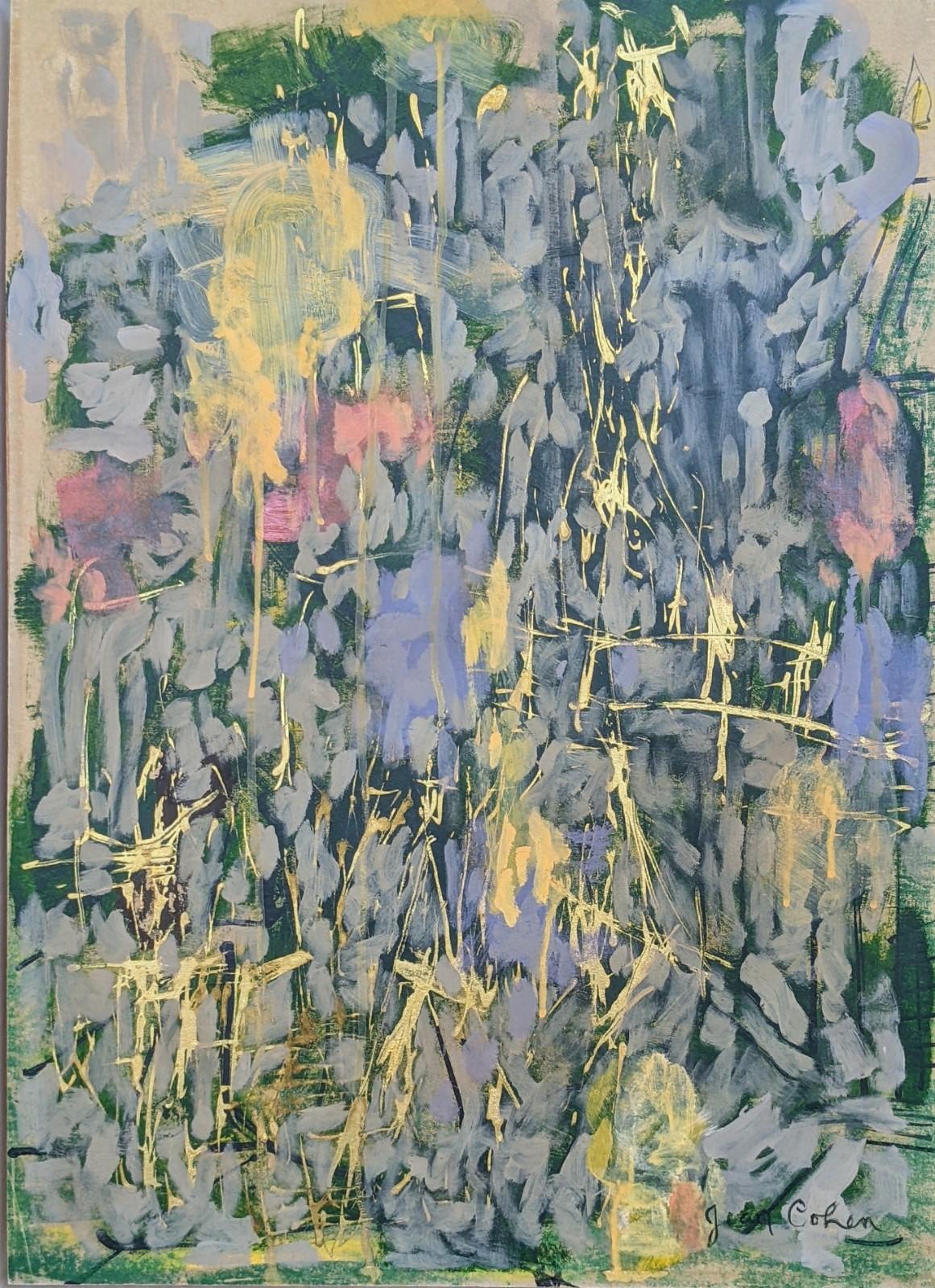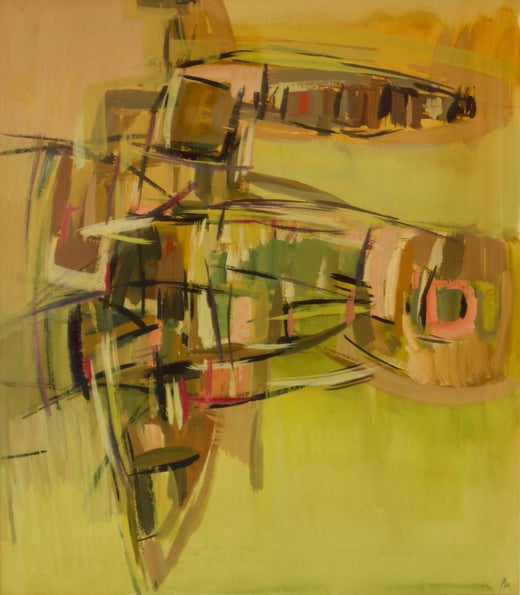John BolamAbstract Piece - Mid 20th Century Mixed Media Watercolor by John Bolam1965
1965
About the Item
- Creator:John Bolam (1922 - 2009, English)
- Creation Year:1965
- Dimensions:Height: 22.25 in (56.5 cm)Width: 20.48 in (52 cm)Depth: 1.38 in (3.5 cm)
- Medium:
- Movement & Style:
- Period:
- Condition:
- Gallery Location:Watford, GB
- Reference Number:
John Bolam
John Bolam was born in 1922 in Amersham, Buckinghamshire. He originally studied painting at the Hornsey School of Art and furniture design at High Wycombe School of Art. He subsequently became a member of the Great Bardfield group of artists. Close friends and colleagues from that time included Michael Rothenstein, Edward Bawden, John Aldridge and Edward Middleditch. From 1970–83, Bolam was Head of the School of Art at Cambridge College of Arts and Technology. He is seen by many as following in the path of the neo-Romantics, most notably John Piper and Graham Sutherland, but his imagery subsequently evolved independently. Bolam was also strongly influenced by French artists such as Braque and Degas as well as the English landscape, especially the Chilterns.
- ShippingRetrieving quote...Ships From: Watford, United Kingdom
- Return PolicyA return for this item may be initiated within 14 days of delivery.
- Abstract Egyptian - Mid 20th Century Watercolour Ancient Egypt by George De GoyaBy George De GoyaLocated in Watford, HertfordshireProfessor George De Goya. PhD. MA. FRSA. Born In Budapest, 1915-1992, related to the Spanish artist Goya on his mother’s side. Educated in Budapest and France where he received a degree in philosophy from the Sorbonne, Paris. Returned to Budapest to study art at the Fine Arts Academy, then continued his studies at the Academie Julienne, Paris, where he was influenced by the post impressionist artists including Picasso, Salvadore, Dali and Chagall. His motto was “history is the inevitable conveyance of great situations by great personalities.” He came to England due to the Hungarian uprising in 1956 where he taught history of art and art appreciation. Started receiving commissions for book and commercial illustrations in 1961. This piece is in a cream wooden frame. Keywords: Abstract, Egyptian...Category
1960s Abstract Abstract Paintings
MaterialsPaper, Watercolor
- Abstract Face - Mid 20th Century Mixed Media Piece by George De GoyaBy George De GoyaLocated in Watford, HertfordshireProfessor George De Goya. PhD. MA. FRSA. Born In Budapest, 1915-1992, related to the Spanish artist Goya on his mother’s side. Educated in Budapest and France where he received a de...Category
1950s Abstract Abstract Paintings
MaterialsPaper, Pastel, Ink, Mixed Media
- Mid Century Abstract Mixed Media Drawing by Rem Raymond Coninckx - BelgiumBy Rem Raymond ConinckxLocated in Watford, HertfordshireRem Raymond Coninckx (1904 - 1974) Rem Raymond Coninckx was born on 28th March in Couvin (Belgium) 1904 and died in Dinan 1974. He was a painter, draftsman, engraver and also creat...Category
1960s Abstract Abstract Drawings and Watercolors
MaterialsPaper, Charcoal, Oil Pastel, Mixed Media
- Abstract Policeman in Village - Mid 20th Century Mixed Media by George De GoyaBy George De GoyaLocated in Watford, HertfordshireProfessor George De Goya. PhD. MA. FRSA. Born In Budapest, 1915-1992, related to the Spanish artist Goya on his mother’s side. Educated in Budapest and France where he received a de...Category
1950s Abstract Abstract Paintings
MaterialsPaper, Charcoal, Pastel, Mixed Media
- Mid Century Abstract Mixed Media Drawing by Rem Raymond Coninckx - BelgiumBy Rem Raymond ConinckxLocated in Watford, HertfordshireRem Raymond Coninckx was born on 28th March in Couvin (Belgium) 1904 and died in Dinan 1974. He was a painter, draftsman, engraver and also created metallic panels and mosaics. Contemporary with Jean Cocteau, Miro, René Magritte, Marc Chagall, Pierre Alechinsky, Karel Appel, Paul Delvaux, Alberto Magnelli etc ... In his drawings there is a great aesthetic sobriety. Individual exhibition at the Galerie Sisley (Brussels) in 1958, gallery La Proue in 1960, La Galerie 081 in 1977 beside Marc Chagall, Pierre Alechinsky, Karel Appel, Fini, Spiliaert, Yvaral etc. This abstract piece was created using...Category
1960s Abstract Abstract Drawings and Watercolors
MaterialsPaper, Charcoal, Oil Pastel, Mixed Media
- Abstract Boat Composition - Mid 20th Century Mixed Media by George De GoyaBy George De GoyaLocated in Watford, HertfordshireProfessor George De Goya. PhD. MA. FRSA. Born In Budapest, 1915-1992, related to the Spanish artist Goya on his mother’s side. Educated in Budapest and France where he received a de...Category
1950s Abstract Abstract Paintings
MaterialsPaper, Charcoal, Pastel
- Marilla Palmer "Communicating Flowers" - Watercolor and Pressed Flowers on PaperBy Marilla PalmerLocated in New York, NYMarilla Palmer Communicating Flowers, 2022 watercolor, pressed petals, sequin, stitching, Durabrite print on Arches Hot Press paper 15 x 11 in. (pal213) This original artwork by Marilla Palmer is a twist on the traditional Victorian botanical drawing, delicately painted with watercolor and collaged pressed flowers...Category
2010s Abstract Impressionist Abstract Drawings and Watercolors
MaterialsPaper, Mixed Media, Watercolor
- Marilla Palmer "Flowers Like Fans" - Watercolor and Pressed Flowers on PaperBy Marilla PalmerLocated in New York, NYMarilla Palmer Flowers Like Fans, 2022 watercolor, pressed petals, sequin, stitching, fabric on Arches Hot Press paper 15 x 11 in. (pal214) This original artwork by Marilla Palmer i...Category
2010s Abstract Impressionist Abstract Drawings and Watercolors
MaterialsFabric, Paper, Mixed Media, Watercolor
- UntitledBy Francesca DiMattioLocated in New York, NYFRANCESCA DIMATTIO untitled, 2007 Gouache And Mixed Media On Paper 12h x 9w in 30.48h x 22.86w cmCategory
Early 2000s Abstract Abstract Drawings and Watercolors
MaterialsMixed Media, Gouache
- "Untitled, " Female Abstract Expressionism, Jean Cohen, Alex KatzBy Jean CohenLocated in New York, NYJean Cohen Untitled, circa 1960 Signed Lower Right: Jean Cohen Mixed Media on artist board 26 3/4 x 19 inches Jean Cohen was an important American painter whose work spans six decades. Jean Cohen lived on Tenth Street in Manhattan, and was a member of the vibrant Tenth Street Artists Galleries during the 1950s and 1960s. She was married to Alex Katz, was a member of the Area Gallery, and showed her work in the Tanager Gallery as well. She has paintings in the permanent collection of the Metropolitan Museum of Art, the New Jersey State Museum, Museum of Modern Art, the University of Maine, and the Whitney Museum of American Art. She has yet to be given the recognition she deserves. Born 1927 Washington Heights, New York Married to painter Alex Katz 1949-1956 Tanager Gallery NYC 1952-1962 Involved with painter John Grillo 1957-1962 Area Gallery NYC 1960-'65 Split time living between NYC and Provincetown c.1957-1980 Landmark Gallery, NYC 1972-1977 Co Founder in '72. Moved to Long Island '85 Died on Long Island, New York 2013 Education: Cooper Union 1945-1948. Studied with John Ferren, Nicholas Marsicano, Morris Kantor, Leo Manso...Category
1960s Abstract Expressionist Abstract Paintings
MaterialsMixed Media, Oil, Gouache, Board
- 1950s Abstract Composition in Brown, Orange and Blue with Black Parallel LinesBy Herbert BayerLocated in Denver, COWatercolor and ink on paper of an abstract composition of brown, orange and blue shapes between black parallel lines throughout the the piece by Herbert Bayer (1900-1985). Presented in a custom black frame with all archival materials. Framed dimensions measure 17 ⅞ x 22 ⅝ x 1 inches. Image size is 10 ¼ x 15 ½ inches. Painting is clean and in very good condition - please contact us for a detailed condition report. Expedited and international shipping is available - please contact us for a quote. About the Artist: Herbert Bayer enjoyed a versatile sixty-year career spanning Europe and America that included abstract and surrealist painting, sculpture, environmental art, industrial design, architecture, murals, graphic design, lithography, photography and tapestry. He was one of the few “total artists” of the twentieth century, producing works that “expressed the needs of an industrial age as well as mirroring the advanced tendencies of the avant-garde.” One of four children of a tax revenue officer growing up in a village in the Austrian Salzkammergut Lake region, Bayer developed a love of nature and a life-long attachment to the mountains. A devotee of the Vienna Secession and the Vienna Workshops (Wiener Werkstätte) whose style influenced Bauhaus craftsmen in the 1920s, his dream of studying at the Academy of Art in Vienna was dashed at age seventeen by his father’s premature death. In 1919 Bayer began an apprenticeship with architect and designer, Georg Schmidthamer, where he produced his first typographic works. Later that same year he moved to Darmstadt, Germany, to work at the Mathildenhöhe Artists’ Colony with architect Emanuel Josef Margold of the Viennese School. As his working apprentice, Bayer first learned about the design of packages – something entirely new at the time – as well as the design of interiors and graphics of a decorative expressionist style, all of which later figured in his professional career. While at Darmstadt, he came across Wassily Kandinsky’s book, Concerning the Spiritual in Art, and learned of the new art school, the Weimar Bauhaus, in which he enrolled in 1921. He initially attended Johannes Itten’s preliminary course, followed by Wassily Kandinsky’s workshop on mural painting. Bayer later recalled, “The early years at the Bauhaus in Weimar became the formative experience of my subsequent work.” Following graduation in 1925, he was appointed head of the newly-created workshop for print and advertising at the Dessau Bauhaus that also produced the school’s own print works. During this time he designed the “Universal” typeface emphasizing legibility by removing the ornaments from letterforms (serifs). Three years later he left the Bauhaus to focus more on his own artwork, moving to Berlin where he worked as a graphic designer in advertising and as an artistic director of the Dorland Studio advertising agency. (Forty years later he designed a vast traveling exhibition, catalog and poster -- 50 Jahre Bauhaus -- shown in Germany, South America, Japan, Canada and the United States.) In pre-World War II Berlin he also pursued the design of exhibitions, painting, photography and photomontage, and was art director of Vogue magazine in Paris. On account of his previous association with the Bauhaus, the German Nazis removed his paintings from German museums and included him among the artists in a large exhibition entitled Degenerate Art (Entartete Kunst) that toured German and Austrian museums in 1937. His inclusion in that exhibition and the worsening political conditions in Nazi Germany prompted him to travel to New York that year with Marcel Breuer, meeting with former Bauhaus colleagues, Walter Gropius and László Moholy-Nagy to explore the possibilities of employment after immigration to the United States. In 1938 Bayer permanently relocated to the United States, settling in New York where he had a long and distinguished career in practically every aspect of the graphic arts, working for drug companies, magazines, department stores, and industrial corporations. In 1938 he arranged the exhibition, “Bauhaus 1919-1928” at the Museum of Modern Art, followed later by “Road to Victory” (1942, directed by Edward Steichen), “Airways to Peace” (1943) and “Art in Progress” (1944). Bayer’s designs for “Modern Art in Advertising” (1945), an exhibition of the Container Corporation of America (CAA) at the Art Institute of Chicago, earned him the support and friendship of Walter Paepcke, the corporation’s president and chairman of the board. Paepcke, whose embrace of modern currents and design changed the look of American advertising and industry, hired him to move to Aspen, Colorado, in 1946 as a design consultant transforming the moribund mountain town into a ski resort and a cultural center. Over the next twenty-eight years he became an influential catalyst in the community as a painter, graphic designer, architect and landscape designer, also serving as a design consultant for the Aspen Cultural Center. In the summer of 1949 Bayer promoted through poster design and other design work Paepcke’s Goethe Bicentennial Convocation attended by 2,000 visitors to Aspen and highlighted by the participation of Albert Schweitzer, Arthur Rubenstein, Jose Ortega y Gasset and Thornton Wilder. The celebration, held in a tent designed by Finnish architect Eero Saarinen, led to the establishment that same year of the world-famous Aspen Music Festival and School regarded as one of the top classical music venues in the United States, and the Aspen Institute for Humanistic Studies in (now the Aspen Institute), promoting in Paepcke’s words “the cross fertilization of men’s minds.” In 1946 Bayer completed his first architecture design project in Aspen, the Sundeck Ski Restaurant, at an elevation of 11,300 feet on Ajax Mountain. Three years later he built his first studio on Red Mountain, followed by a home which he sold in 1953 to Robert O. Anderson, founder of the Atlantic Richfield Company who became very active in the Aspen Institute. Bayer later designed Anderson’s terrace home in Aspen (1962) and a private chapel for the Anderson family in Valley Hondo, New Mexico (1963). Transplanting German Bauhaus design to the Colorado Rockies, Bayer created along with associate architect, Fredric Benedict, a series of buildings for the modern Aspen Institute complex: Koch Seminar Building (1952), Aspen Meadows guest chalets and Center Building (both 1954), Health Center and Aspen Meadows Restaurant (Copper Kettle, both 1955). For the grounds of the Aspen Institute in 1955 Bayer executed the Marble Garden and conceived the Grass Mound, the first recorded “earthwork” environment In 1973-74 he completed Anderson Park for the Institute, a continuation of his fascination with environmental earth art. In 1961 he designed the Walter Paepcke Auditorium and Memorial Building, completing three years later his most ambitious and original design project – the Musical Festival Tent for the Music Associates of Aspen. (In 2000 the tent was replaced with a design by Harry Teague.) One of Bayer’s ambitious plans from the 1950s, unrealized due to Paepcke’s death in 1960, was an architectural village on the outskirts of the Aspen Institute, featuring seventeen of the world’s most notable architects – Walter Gropius, Marcel Breuer, I.M. Pei, Minoru Yamasaki, Edward Durrell Stone and Phillip Johnson – who accepted his offer to design and build houses. Concurrent with Bayer’s design and consultant work while based in Aspen for almost thirty years, he continued painting, printmaking, and mural work. Shortly after relocating to Colorado, he further developed his “Mountains and Convolutions” series begun in Vermont in 1944, exploring nature’s fury and repose. Seeing mountains as “simplified forms reduced to sculptural surface in motion,” he executed in 1948 a series of seven two-color lithographs (edition of 90) for the Colorado Springs Fine Arts Center. Colorado’s multi-planal typography similarly inspired Verdure, a large mural commissioned by Walter Gropius for the Harkness Commons Building at Harvard University (1950), and a large exterior sgraffito mural for the Koch Seminar Building at the Aspen Institute (1953). Having exhausted by that time the subject matter of “Mountains and Convulsions,” Bayer returned to geometric abstractions which he pursued over the next three decades. In 1954 he started the “Linear Structure” series containing a richly-colored balance format with bands of sticks of continuously modulated colors. That same year he did a small group of paintings, “Forces of Time,” expressionist abstractions exploring the temporal dimension of nature’s seasonal molting. He also debuted a “Moon and Structure” series in which constructed, architectural form served as the underpinning for the elaboration of color variations and transformations. Geometric abstraction likewise appeared his free-standing metal sculpture, Kaleidoscreen (1957), a large experimental project for ALCOA (Aluminum Corporation of America) installed as an outdoor space divider on the Aspen Meadows in the Aspen Institute complex. Composed of seven prefabricated, multi-colored and textured panels, they could be turned ninety degrees to intersect and form a continuous plane in which the panels recomposed like pieces of a jigsaw puzzle. He similarly used prefabricated elements for Articulated Wall, a very tall free-standing sculpture commissioned for the Olympic Games in Mexico...Category
1950s Abstract Geometric Abstract Drawings and Watercolors
MaterialsPaper, Ink, Mixed Media, Watercolor
- "Abstract Butterfly, " Mixed Media Ink and Watercolor signed by Joan DvorskyBy Joan DvorskyLocated in Milwaukee, WIIn this artwork, Milwaukee-based artist Joan Dvorsky presents the viewer with a composition of shapes and colors that abstractly and subtly resemble a beautiful, colorful and complex...Category
2010s Abstract Mixed Media
MaterialsInk, Mixed Media, Watercolor






